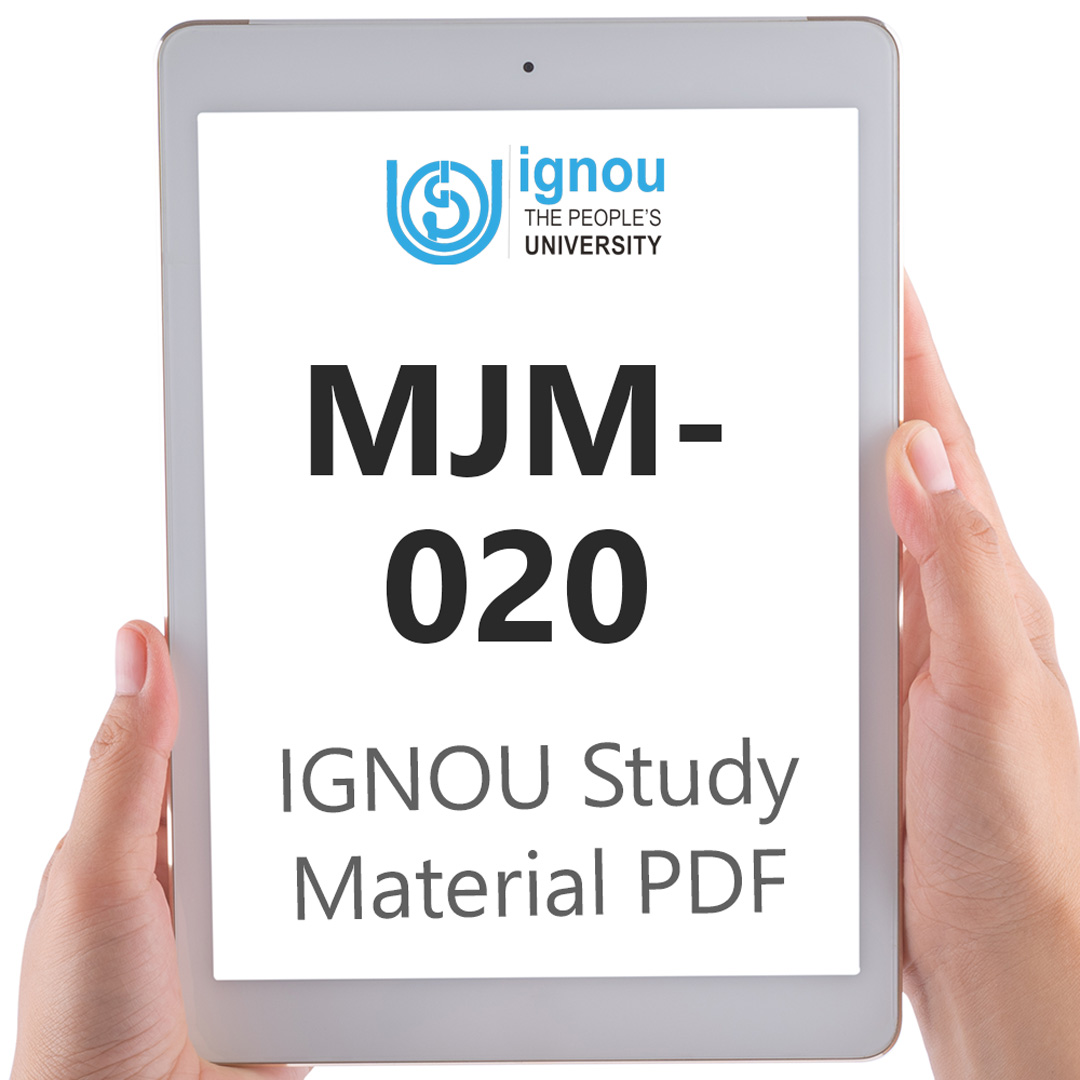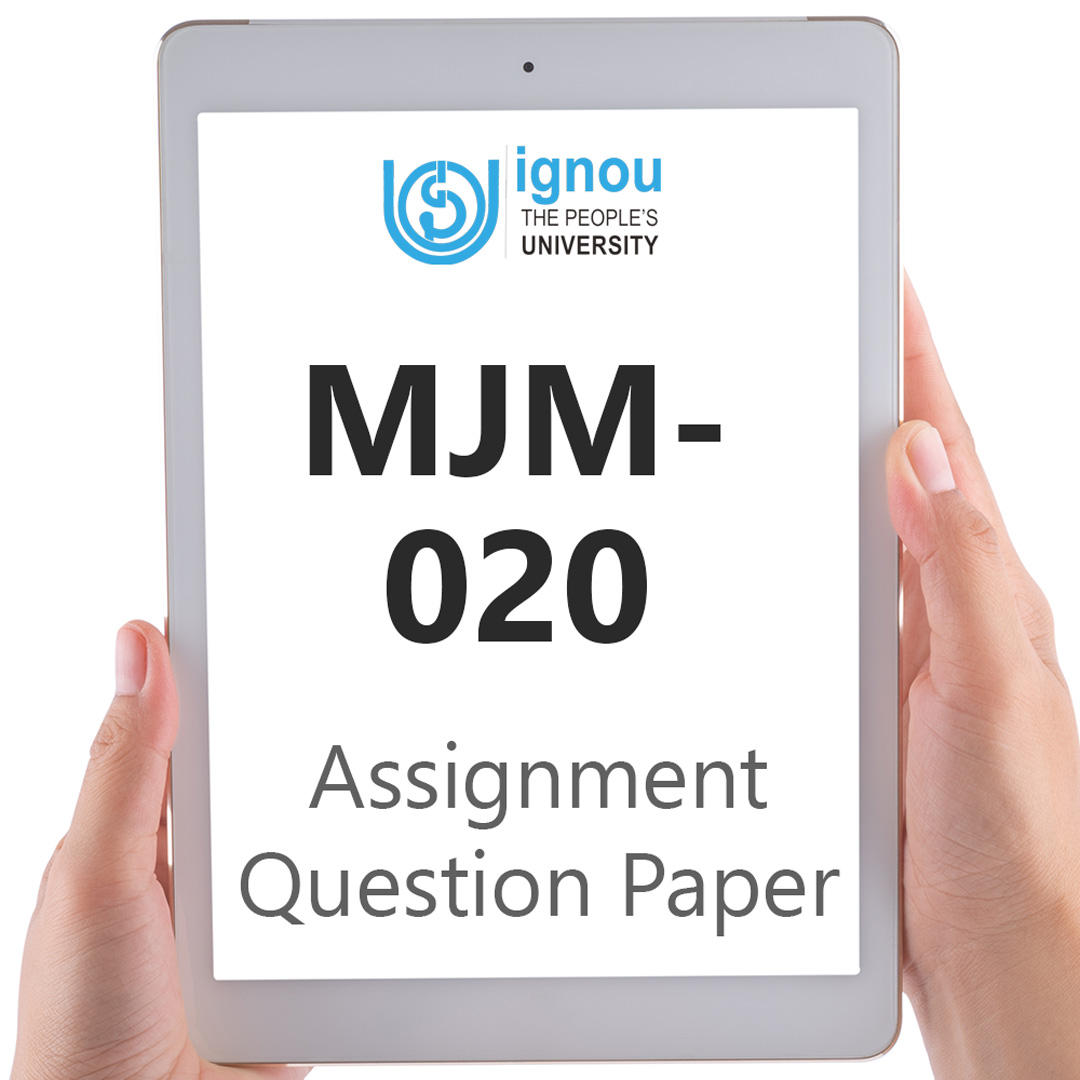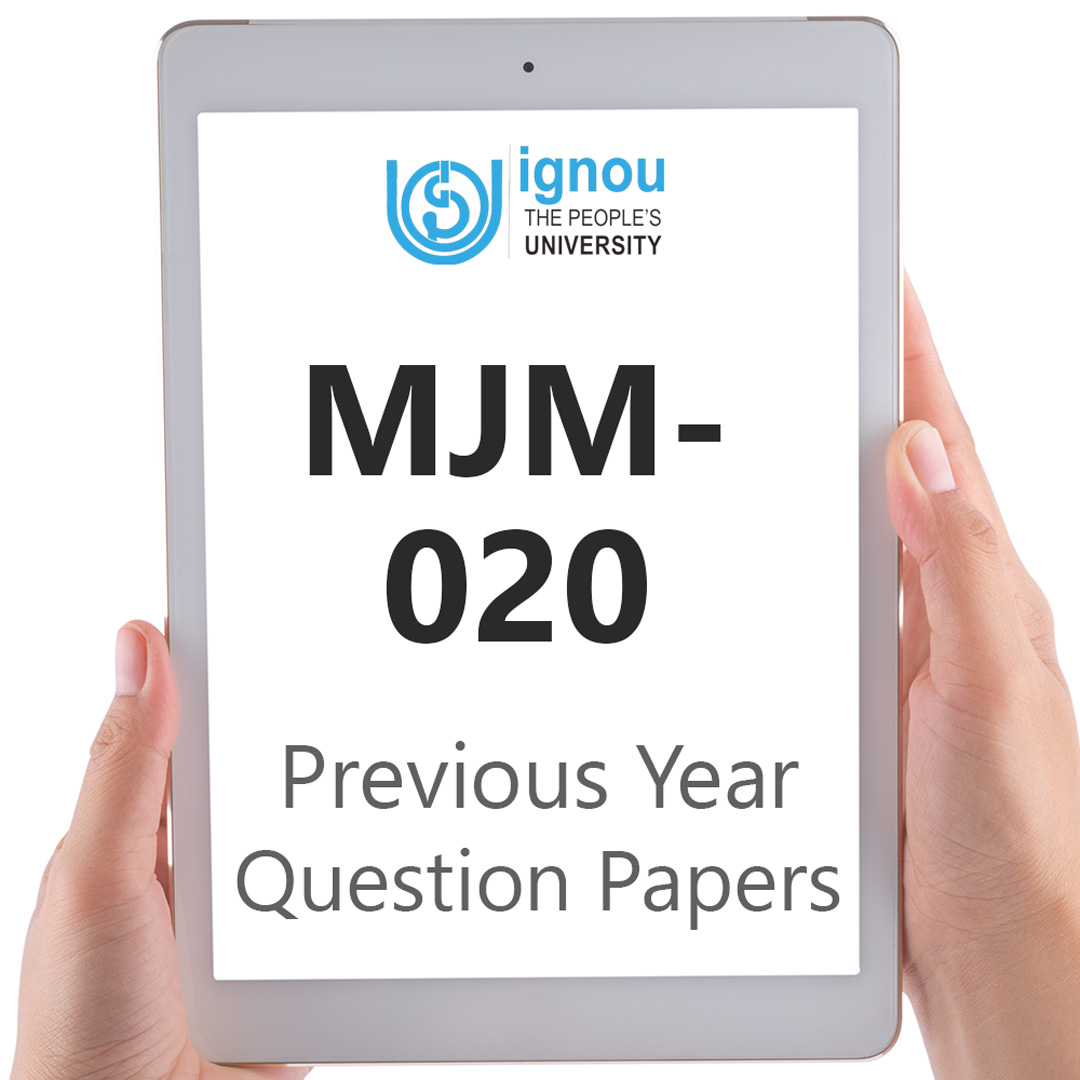If you are looking for MJM-020 IGNOU Solved Assignment solution for the subject Introduction to Journalism and Mass Communication, you have come to the right place. MJM-020 solution on this page applies to 2023-24 session students studying in MAJMC, PGJMC, MAJEM, PGDEME courses of IGNOU.
MJM-020 Solved Assignment Solution by Gyaniversity
Assignment Code: MJM-020 /ASST/July23
Course Code: MJM-020
Assignment Name: Introduction to Journalism and Mass Communication
Year: 2023
Verification Status: Verified by Professor
Q1) Choose any two media theories of your choice and analyse how it fits in the current media scenario.
Ans) The Agenda-Setting Theory and the Uses and Gratifications Theory are two notable media theories that continue to be relevant in the present media landscape. These theories significantly shape our knowledge of the effects of media and the involvement of audiences.
a) Agenda-Setting Theory:
1) Overview: According to the Agenda-Setting Theory, not only does the media tell people what to believe, but it also tells them what to think about. It places an emphasis on the powerful role that the media plays in bringing particular concerns to light, which in turn shapes the perceived priorities of the general public.
2) Current Relevance: Even in this day and age, when there are so many different kinds of media outlets and social media platforms, the notion is still relevant. A lot of the time, the agenda is determined by social media algorithms and trending issues, which determine what attracts the most attention and visibility from the general audience. It is possible for issues to quickly become prominent or to be overshadowed due to the influence that the media has to set the agenda.
3) Example: The focus that the media places on particular storylines, events, or perspectives during key events such as elections or social movements has an effect on the public discourse associated with those events. Trends in social media and coverage in the news both contribute to the framing of topics, which in turn has an effect on what is seen to be relevant in public debate.
b) Uses and Gratifications Theory:
1) Overview: As well as the Benefits and Pleasures The active role that media audiences play is the primary emphasis of theory. It proposes that people select content from the media based on their wants, seeking fulfilment in a variety of ways such as information, enjoyment, the reinforcement of their own identity, or social integration.
2) Current Relevance: Users actively select and engage with media that is in accordance with their interests and requirements in this day and age of on-demand content and tailored media experiences. Streaming platforms, social media, and tailored news feeds all cater to individual preferences, which is consistent with the predictions made by the Uses and Gratifications Theory.
3) Example: Exemplifying the principle is the proliferation of platforms such as Netflix, which provide users with the ability to select from a wide range of material genres according to their own preferences. People are able to actively curate and consume content that is aligned with their interests through the usage of social media platforms, which are powered by user-generated content. This contributes to a more personalised media environment.
Utilizations and gratifications, in addition to the Agenda-Setting Theory Comprehending the dynamics of the modern media landscape requires understanding theory, which continues to be relevant. These theories continue to be relevant in explaining how the media shapes public discourse and how individuals actively engage with and derive gratification from media content. The interaction between media institutions, user choices, and the dynamic nature of digital platforms highlights the ongoing relevance of these theories. In light of the fact that the media is constantly undergoing change, these theories offer extremely helpful frameworks for studying the complex relationships that exist between the media, audiences, and the effects of society.
Q2) What are the ways in which internet has affected the traditional media of print and electronic? Cite industry reports indicating internet proliferation in India during the COVID times.
Ans) The internet has significantly impacted traditional media, including print and electronic formats, transforming their distribution, consumption patterns, and revenue models. In India, the proliferation of the internet, particularly during the COVID-19 pandemic, has accelerated these changes.
Impact on Print Media
a) Shift to Digital Platforms: The rise of online news portals and e-papers has led to a decline in print circulation. Many traditional newspapers now offer digital subscriptions or have established online versions to adapt to changing reader preferences.
b) Advertising Revenue: Advertisers increasingly favour online platforms due to their wider reach and targeted advertising capabilities, diverting revenue away from traditional print media. This shift has led print media to explore digital advertising models to sustain revenue.
c) Content Accessibility: The internet has democratized news access. Readers prefer instant news updates through websites and mobile apps over waiting for print editions. This has prompted traditional print media to focus on creating online content to stay relevant.
Impact on Electronic Media
a) Changing Viewing Habits: With the internet offering on-demand content, viewers have shifted from scheduled TV programming to streaming services, impacting television ratings and ad revenues. OTT platforms have gained popularity, offering a wide range of content.
b) Content Diversification: Electronic media now produces content specifically tailored for online consumption. YouTube channels, podcasts, and social media content have become integral for electronic media outlets to engage with audiences beyond traditional TV programming.
c) Digital News Consumption: News channels have also expanded their digital presence. Viewers prefer consuming news online through websites, mobile apps, or social media platforms, challenging the dominance of traditional TV news.
Internet Proliferation in India during COVID Times
According to the "ICUBE 2020" report by BARC India and Nielsen, India saw a substantial increase in internet consumption during the COVID-19 pandemic:
a) Internet Usage Surge: The survey stated that there was a 12 percent increase in overall internet consumption, with rural India being the primary driver of this gain. Rural India saw a 14 percent increase in the number of people using the internet.
b) Growth in OTT and News Apps: With a 13 percent increase in the amount of time spent on OTT platforms on a daily basis, the report noted a considerable surge in the usage of over-the-top (OTT) platforms. The number of people using news apps also increased by 36%.
c) E-commerce and Social Media: As a result of the epidemic, there was a 42 percent increase in the use of e-commerce apps and a 23 percent increase in the use of social media messaging apps.
d) Shift in Media Consumption: The report underlined a shift from traditional media to digital platforms, with consumers spending more time online for entertainment, news, and social interaction due to lockdowns and restrictions.
The internet's impact on traditional media in India, particularly during the COVID-19 pandemic, has been transformative. Both print and electronic media have adapted by embracing digital platforms to cater to changing consumer preferences and behaviours. The proliferation of the internet has accelerated this shift, prompting traditional media to innovate and evolve to remain competitive in an increasingly digital landscape.
Q3) Select any two language dailies of your choice. Compare their editorial pages and present the differences in a tabular form.
Ans) Comparison of the Editorial Pages of Two Renowned Indian Newspapers, the Times of India, and the Hindu:
The Times of India tends to offer succinct editorials catering to a broader audience, providing diverse perspectives on various topics in a concise manner. Its editorials often reflect popular sentiment and cover a wide spectrum of subjects, including current affairs and entertainment.
On the other hand, The Hindu presents more detailed and analytical editorials, focusing on comprehensive coverage of socio-political and economic issues. It leans toward a progressive stance, delivering opinions grounded in thorough research and analysis, appealing to readers seeking depth and nuanced perspectives.
Both newspapers serve diverse readerships with varying preferences in terms of depth, style, and coverage, catering to audiences seeking different levels of engagement and analysis in their editorial content.
Q4) Which elements of a podcast make it unique and better than earlier broadcasts? Write the concept and idea of a podcast for children up to ten years of age.
Ans)
Elements of a Podcast that Make it Unique
a) On-Demand Accessibility:
Concept: Unlike traditional broadcasts, podcasts are accessible on-demand, allowing listeners to choose when and where they want to consume content. This flexibility caters to busy schedules and diverse audience preferences.
b) Niche Content and Diverse Voices:
Concept: Podcasts cover a vast array of niche topics, providing a platform for diverse voices and perspectives. This allows for a more inclusive range of content, serving specific interests and fostering a sense of community among listeners.
c) Intimacy and Connection:
Concept: Podcasts often create a more intimate listening experience. The conversational tone and personal narratives establish a connection between hosts and listeners, fostering a sense of engagement and community.
d) Creative Storytelling:
Concept: Podcasts leverage creative storytelling techniques, using sound effects, music, and immersive narratives to enhance the listener's experience. This dynamic storytelling distinguishes podcasts from traditional broadcasts, making them more engaging.
e) Accessibility to Independent Creators:
Concept: The accessibility of podcasting platforms allows independent creators to produce and share content without the need for elaborate production setups. This democratization of content creation fosters a diverse and vibrant podcasting landscape.
Podcast Concept for Children Up to Ten Years of Age
Title: "ImagiPlay Wonderland"
a) Concept and Idea:
"ImagiPlay Wonderland" is a podcast designed specifically for children up to ten years old, aiming to create a magical audio space where imagination knows no bounds. The podcast is built on the idea that storytelling and play are essential elements of a child's development, offering a delightful and educational journey for young listeners.
b) Episodic Format:
Each episode transports children to a whimsical world filled with captivating stories, playful adventures, and imaginative scenarios. The format includes a mix of engaging narratives, interactive games, and educational segments to make learning fun.
c) Key Elements:
1) Interactive Storytelling: The podcast encourages active participation through interactive storytelling, allowing children to influence the direction of the narrative.
2) Educational Nuggets: Short segments introduce educational content seamlessly, offering age-appropriate lessons in language, numeracy, and social skills.
3) Enchanting Soundscapes: The use of vibrant soundscapes, whimsical music, and lively sound effects enhances the overall listening experience, immersing children in the magical world of ImagiPlay Wonderland.
4) Character Engagement: Lovable characters guide the adventures, each with unique personalities, fostering a sense of connection and empathy among young listeners.
5) Parental Involvement: ImagiPlay Wonderland recognizes the importance of parental involvement in a child's media consumption. Episodes include suggested activities and discussion points for parents to engage with their children.
d) Benefits:
1) Encourages imaginative thinking and creativity.
2) Reinforces educational concepts in an entertaining manner.
3) Fosters language development and listening skills.
4) Provides a safe and age-appropriate digital space for children.
"ImagiPlay Wonderland" strives to be a podcast that not only captivates young minds but also nurtures their cognitive, emotional, and social development through the power of storytelling and play.
Q5) Conceptualise and plan a fund raiser to promote tribal art through digital means.
Ans)
Fundraiser Concept: "ArtConnect: Bridging Tribes Digitally"
a) Objective:
The primary goal of the fundraiser is to promote and preserve tribal art by leveraging digital platforms. "ArtConnect" aims to bridge the gap between tribal artisans and art enthusiasts while raising funds to support the communities and ensure the continuity of their artistic traditions.
b) Components of the Fundraiser:
1) Digital Art Auction:
Concept: Curate a collection of authentic tribal artworks and organize an online art auction. Engage renowned tribal artists and collaborate with art institutions to showcase a diverse range of pieces, including paintings, sculptures, and crafts.
2) Virtual Art Exhibitions:
Concept: Host virtual art exhibitions featuring the works of tribal artisans. Use 3D technology to create immersive online galleries, allowing visitors to explore and appreciate the art from the comfort of their homes.
3) Live Art Demonstrations:
Concept: Organize live streaming sessions where tribal artists demonstrate their craft. This provides a unique opportunity for the audience to witness the creation process, ask questions, and gain insights into the cultural significance of each art form.
4) Artisan Stories Podcast:
Concept: Launch a podcast series featuring interviews with tribal artisans. Share their personal stories, experiences, and the cultural roots of their art. This humanizes the artists, creating a connection between the audience and the creators.
5) Online Art Workshops:
Concept: Conduct virtual art workshops led by tribal artisans. Participants can learn traditional techniques, creating a hands-on experience that fosters appreciation for the intricacies of tribal art.
6) Crowdfunding Campaign:
Concept: Launch a crowdfunding campaign to raise funds for tribal communities. Clearly communicate the purpose of the fundraiser, emphasizing the importance of preserving cultural heritage and supporting the livelihoods of tribal artists.
7) Collaborations with Influencers:
Concept: Partner with social media influencers and art enthusiasts to promote the fundraiser. Influencers can share their experiences, engage their followers, and encourage participation in the various fundraising activities.
c) Utilization of Funds:
1) Artisan Support: Direct a significant portion of the funds towards providing financial assistance, training, and resources to tribal artisans to sustain their craft.
2) Cultural Preservation Initiatives: Allocate funds for projects aimed at preserving tribal languages, traditions, and cultural practices integral to the artistic heritage.
3) Digital Infrastructure: Invest in digital tools and platforms to empower tribal communities to showcase and sell their art online independently.
4) Education and Awareness: Dedicate funds to educational programs that raise awareness about tribal art, fostering a deeper understanding and appreciation among the wider audience.
"ArtConnect: Bridging Tribes Digitally" strives to create a sustainable model that not only promotes tribal art but also empowers the artists and communities behind these rich cultural expressions. Through digital platforms, the fundraiser seeks to transcend geographical barriers and connect art lovers with the profound beauty of tribal traditions.






